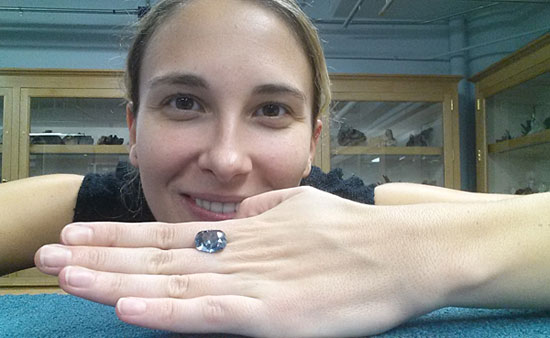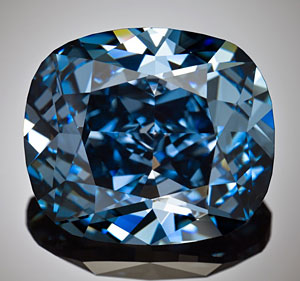Rhapsody in blue
September 10, 2014
It was the kind of discovery that can rock a gem scientist’s world.
Eloïse Gaillou, an associate curator at the Los Angeles County Natural History Museum, started picking up social media chatter early this year about a 29.6 carat rough diamond found in South Africa.
She hardly imagined that just months later she would be on a team at the Smithsonian Institution conducting scientific tests on the rare diamond—now exquisitely cut to 12 carats and dubbed the Blue Moon for its exceptional color—let alone helping to host the super-stone’s visit to Los Angeles, where it will be on display in the museum’s gem vault from September 13 through January 6.
“We tweeted about it, we blogged about it, never thinking that it would come to us eventually,” Gaillou said.
The Blue Moon will join a collection of 240 colored diamonds called the “Aurora Butterfly of Peace” now on display at the museum.
“Putting those two collections together is really going to be an exceptional thing for the public to see. You won’t be able to see that many colored diamonds again in your life,” Gaillou said. “I’m sure we’re going to blow people’s minds.”
The idea for the temporary exhibition was launched, she said, after the owner of the Butterfly of Peace diamonds put her in touch with Cora International, the diamond firm that owns the Blue Moon. Cora International agreed to allow the museum to display the rare stone, whose distinctive color comes from traces of boron within its carbon structure.
It is likely to be the only public display of the diamond before it disappears discreetly into a private collection, Gaillou said.
Gaillou, who grew up in the Brittany region of France, has childhood memories of prospecting for fossils and minerals in local fields and on vacations with her parents in the Alps. As a geologist specializing in gemstones, she focused on sapphires for her master’s degree and opals for her doctorate, but became interested in diamonds when she pursued a diploma in gemology. It was at the Smithsonian, where she did nearly five years of post-doctoral work before joining the county’s Natural History Museum in 2012, that she began to turn her attention to rare pink and blue diamonds—“the ones that you don’t usually have the opportunity to study unless you are in a very special place that owns such diamonds.”
Even without glamorous visitors like the Blue Moon and the Butterfly of Peace passing through, Gaillou said the NHM’s gem collection is “amazing,” second only to the Smithsonian’s.
While she got a thrill from handling the Blue Moon during the scientific tests with her former colleagues at the Smithsonian last month, it’s clear that science—not jewelry—is this curator’s best friend.
She was most wowed by the Blue Moon’s red afterglow—“a good 20 seconds!”—after it was exposed to UV light. That kind of phosphorescence, she said, is usually associated only with the finest blue diamonds, like the Hope and the Wittelsbach-Graff.
“Diamonds, they’re pretty, don’t get me wrong. But from a scientific point of view, I just love studying diamonds. They give us a clue not only about the deep earth, but also the evolution of the earth from about 3 billion years ago until now,” she said. “You would be done looking at a diamond in about five minutes if you were just looking at its aesthetics. But from the scientific point of view, I have been working on them for over seven years now.”
Still, like a pastry chef who steers clear of macarons, Gaillou said she doesn’t indulge much in sparkling bijoux in her private life.
“I see so many beautiful things that I don’t even buy jewelry myself, or not much. I think it has probably killed it for me,” she laughed.
But she does get a charge out of walking through the museum’s gem exhibits on the way to her office each day, and overhearing the oohs and aahs from visitors.
She’s expecting to get quite an earful in the months ahead. Even though she has studied more than 100 diamonds, including legendary stones like the Hope, the Wittelsbach-Graff and the Blue Heart, she considers the Blue Moon exceptional.
“You never get tired of looking at big gems like that,” said Gaillou, 34. “There’s just something about this color. It’s something that you will never forget.”
“Some gemstones are just dead, and some gemstones are just alive. And definitely this one is alive. You see it. It’s just aglow. The cut is wonderful, the fire is amazing. After that, as to the personality of the Blue Moon, I think that everybody will have a different answer. You just have to come and see the diamond by yourself and make up your mind on that.”
Posted 9/4/14
















 405 bridge work causes a stink
405 bridge work causes a stink